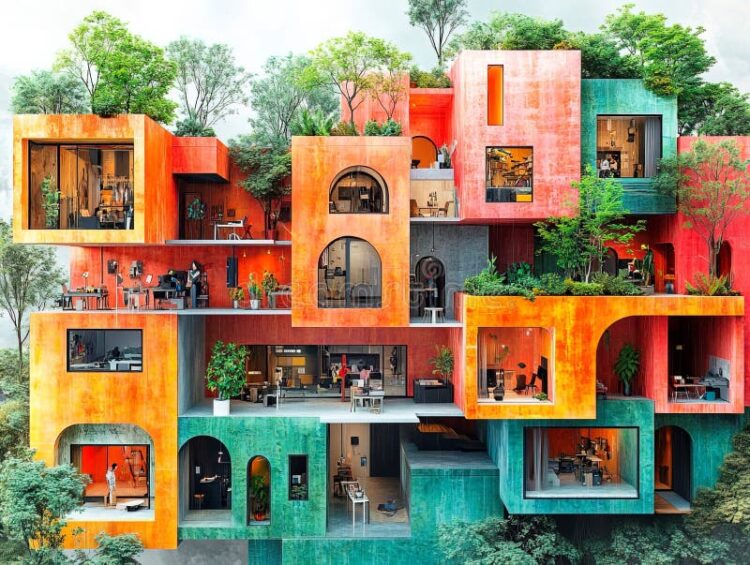In today’s fast changing world, where climate change is no longer a distant worry but a real threat, sustainability has become more than just a buzzword it’s a design necessity. Modern architecture is going through a green revolution, and it’s changing not only how buildings look, but also how they function in harmony with the planet.
Gone are the days when “green building” just meant adding a few solar panels on the roof. Now, sustainability is woven into the very core of architectural design. From the foundation to the roof, eco conscious decisions are reshaping the future of cities and living spaces.
Let’s dive into how sustainability is influencing modern architecture and why this shift is more than just a trend it’s a transformation.
A. Design Starts With the Environment in Mind
One of the biggest changes in modern architecture is how much attention is now given to the local environment before a building even breaks ground. Architects look at factors like:
Sunlight direction
Wind patterns
Rainfall
Local materials
By understanding these natural elements, buildings can be designed to work with nature instead of against it. This might mean positioning windows to take advantage of natural light or using thick walls made from local earth to regulate indoor temperature.
B. Energy Efficiency Is the New Standard
In the past, energy efficiency was an extra bonus. Now, it’s a must have.
Architects are integrating energy saving systems right into the design:
Smart lighting that adapts to daylight
Solar panels that power the home
Insulation materials that reduce heating and cooling needs
The goal is to reduce the building’s overall carbon footprint. A well designed building can dramatically cut down on energy use without sacrificing comfort.
C. Natural Ventilation Beats Air Conditioning

Rather than relying heavily on air conditioning, modern sustainable buildings often focus on better airflow.
Architects use strategies like:
Cross ventilation (windows placed across from each other)
High ceilings that allow heat to rise
Vents or skylights that release hot air naturally
These techniques not only save energy but also create a more pleasant indoor environment.
D. Sustainable Materials Lead the Way
The construction industry is known for being resource heavy, but that’s changing. Architects are now seeking out materials that are:
Recycled or recyclable
Locally sourced
Low in toxic chemicals
Renewable (like bamboo or cork)
Using sustainable materials reduces environmental impact and often improves indoor air quality as well.
E. Green Roofs and Living Walls Add Function and Beauty
Have you noticed buildings lately with plants growing on the walls or rooftops? These aren’t just for looks—they’re a key part of sustainable design.
Green roofs and vertical gardens help by:
Reducing heat absorption
Cleaning the air
Managing rainwater
Supporting local wildlife
Plus, they add a splash of green to cityscapes that are often dominated by concrete and steel.
F. Water Conservation Is Built In
Sustainable buildings pay close attention to how they use water. Some common features include:
Rainwater harvesting systems
Low flow toilets and faucets
Greywater recycling systems
These designs reduce strain on municipal water systems and help conserve a precious resource especially in dry climates.
G. Passive Solar Design Makes a Big Difference
Passive solar design means using the sun’s energy without mechanical systems. Think of it as a smart way of placing and designing things to naturally heat or cool a space.
For example:
South facing windows (in the northern hemisphere) to capture winter sun
Overhangs to block harsh summer rays
Thermal mass (like concrete floors) to store heat
This type of design can slash heating and cooling bills while keeping a space naturally comfortable.
H. Smart Technology Supports Sustainable Living
Smart home systems aren’t just for convenience anymore they’re key players in energy management. These technologies can:
Monitor energy use in real time
Adjust heating and cooling automatically
Alert homeowners when systems need maintenance
The data collected helps homeowners make smarter decisions and reduce waste.
I. Reuse and Adaptation Over Demolition
Another important shift is the move toward reusing existing structures. Instead of tearing down old buildings, architects are finding creative ways to update and adapt them.
This has benefits like:
Reducing construction waste
Preserving cultural history
Saving energy that would be used for new materials
Adaptive reuse gives new life to forgotten spaces and can be more sustainable than building from scratch.
J. Community-Centered Design for a Better Future

Finally, sustainable architecture isn’t just about individual buildings it’s about entire communities. Architects are thinking about how spaces serve the people who live in and around them.
This includes:
Mixed use developments (homes, shops, offices in one space)
Public transportation access
Walkable neighborhoods
Shared green spaces
By designing with community needs in mind, architects are helping to build more connected, resilient, and eco friendly cities.
Sustainability in modern architecture is no longer an option it’s an expectation. As climate challenges grow, architects are stepping up with creative, thoughtful designs that respect both people and the planet. The buildings of tomorrow won’t just be smart and stylish they’ll be sustainable from the inside out.
Whether it’s through natural ventilation, green rooftops, or recycled materials, every eco friendly detail makes a difference. And in the process, architecture is being reshaped into something not just functional, but truly forward thinking.








